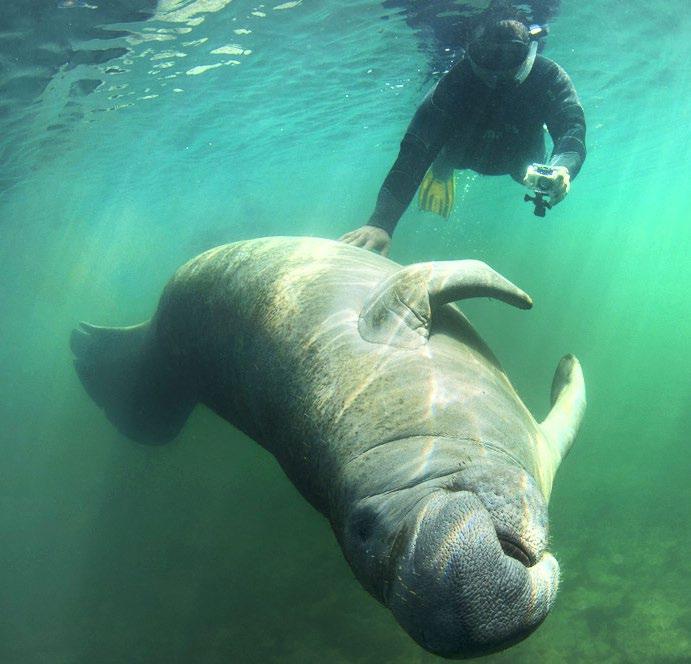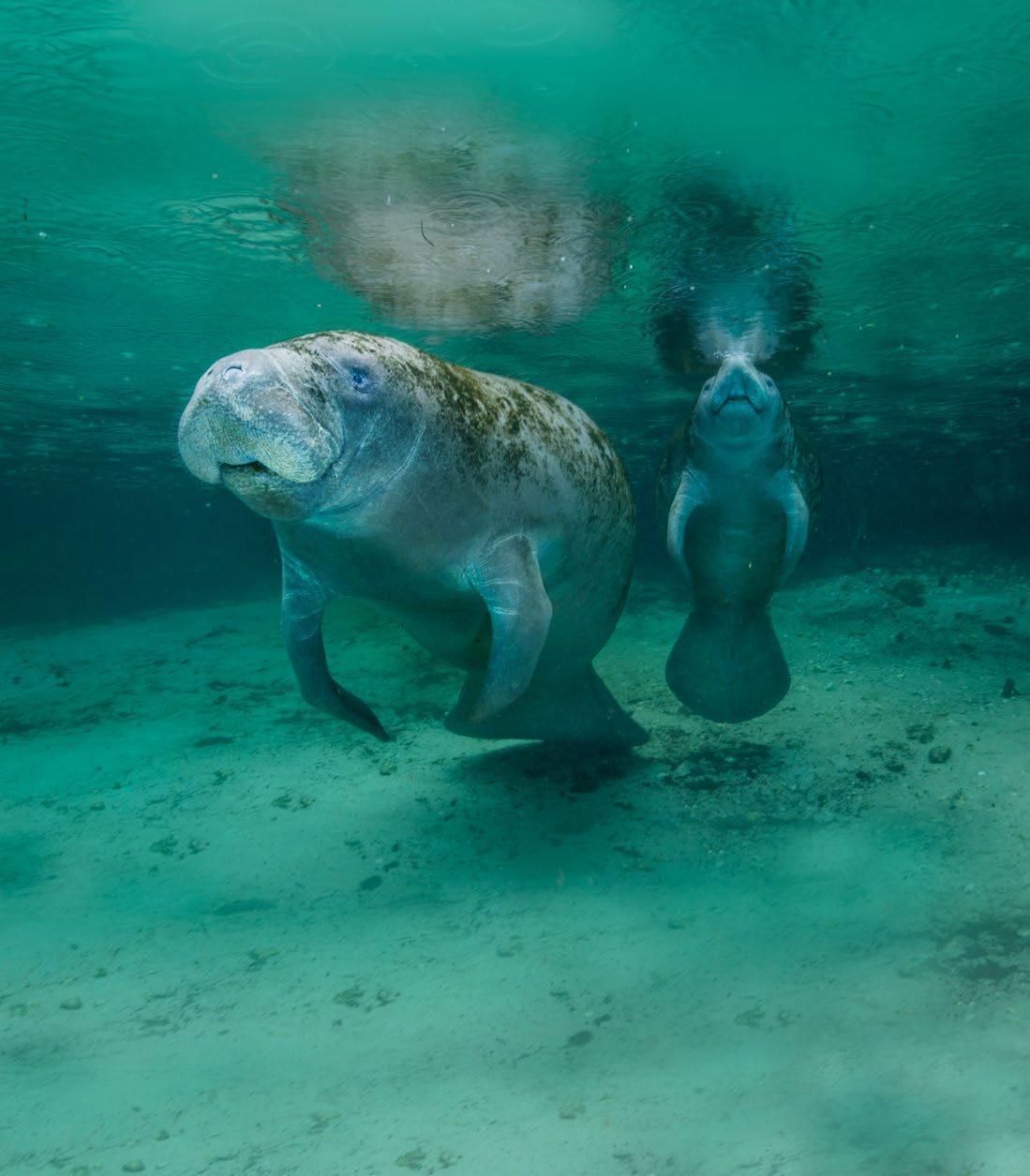
6 minute read
Manatee Mania
from Nov/Dec 2019
DAYCATION—CRYSTAL RIVER & CENTRAL FLORIDA
Manatee Mania By Carlton Ward Jr., Kevin Mims, Jill Martin & Lauren Tjaden • Text Courtesy Visit Florida
Advertisement
Before we dive into the water, let’s talk a little bit about what you’re going to see. The West Indian manatees are very large aquatic mammals, weighing in around 1,000 pounds and measuring about 10 feet in length. They are docile, slow-moving swimmers that eat 10 to 15 percent of their body weight daily in aquatic plants. They often surface for air every 30 seconds while active and every 20 minutes while sleeping.
Manatees have no natural enemies and the biggest threats to their survival are interactions with watercraft and loss of habitat. They were placed on the endangered species list in 1966 and have since been under close watch in order to ensure the survival of the species. Are you ready?

SNORKEL WITH THE MANATEES-The water in the Three Sisters area of the Crystal River was so clear that I might as well have been gazing through air. I could see as many as 20 manatees at one time. Some rested like giant blimps on the river’s bottom, but many were close to snorkelers. I shivered inside my black wetsuit, listening to the quiet sounds of my breathing and the motion of my arms as they pulled me through the water.
One of the manatees seemed smitten with an underwater photographer. The photographer sported a large belly that gave him roughly the same profile as the manatee, so perhaps the manatee felt some kinship on that basis. Whatever the reason, the creature’s affection was obvious. The manatee lay on the bottom of the river, wrapping his flippers around the photographer’s leg. Another manatee was fascinated by his camera, poking his soft, grey muzzle toward the lens.
A calf was the first manatee to approach me. I guess he approved of the way I scratched his back—softly using my nails to rub the algae off of him, as I had been instructed— because he flipped over to reveal his pale stomach to me, which I also scratched. While he was on his back, I could see the little toenails on his flippers, reminiscent of an elephant’s, which made sense, because the elephant is the manatees’ closest living relative. Some of the manatees rested in their sanctuary, clearly aware of where people were allowed and where they were not. The sanctuary is an area marked off by rope and buoys, so that if a manatee wants to breed, eat, nurse a calf, or just take a snooze, it won’t be bothered.
I never ran out of manatees to play with or watch. I could have stayed there forever, because it was such an incredible, unbelievable thing I was getting to do, but eventually I was frozen enough I could barely bend my fingers or speak, so I paddled over to our boat to swig hot coffee and swaddle myself in towels. But I couldn’t stand to miss out on the fun for long, so I glided out into the water for one last goodbye scratch before we headed back to the dock.
My trip only lasted for four hours, yet I still remember it—and I’m sure I’ll always remember it. I even dream about it sometimes, gazing into the eyes of a gentle giant who swam across the river to greet me.
If you go, here a few tips. When you first enter the water, it’s easy to become overwhelmed by the size of these gentle giants. Don’t panic—they won’t hurt you. Relax, float on the surface, and enjoy the experience. The calmer you are the more likely a manatee might swim over.
Bring lots of warm clothes. The water is a constant 72 degrees, and you’ll be wearing a wetsuit, so it’s not bad when you are in the water. However, when you get out you’ll probably feel chilled. If your tour doesn’t include warm drinks, bring a thermos with your own. (The colder it is, the more active the manatees will be, so you don’t want balmy weather).
Ask what equipment your tour includes and what you will need to rent. A mask, snorkel, and wetsuit are necessary, but fins are not. You’ll mainly only need to float, not swim, and if you are unfamiliar with using fins you can stir up the water and frighten the manatees. My trip with Sunshine River Tours included all of the necessary equipment.
This is mainly a winter-time activity, since that’s when the manatees migrate into the warm water to feed. A few small groups of manatees live in the river year round, so it may be possible for you to have a quality experience at other times of the year. Ask your guide service for advice.
Tipping the boat crew is customary. Consider spending the night before your trip in the area. The manatees are most active in the morning, so some tours begin at the crack of dawn. The state parks here don’t offer camping, but they can provide a list of 20 places in or close to Crystal River that do. I opted for a comfy bed at the Best Western in Crystal River.

Follow the rules for manatee interaction. The tour guides tend to be staunch conservationists that take the welfare of these endangered animals seriously. You can only touch manatees with one hand at a time, so that there is never any doubt that you are trying to ride them or hold them. You are not allowed to chase them, and all interaction has to be on their terms. Feeding them is prohibited. Stay out of the sanctuaries, even with your arms.
VISIT THE FLORIDA MANATEE FESTIVAL-If you’re looking for a cool event in January, then you need to take part in the fun at the Florida Manatee Festival January 18-19.
The fun happens in downtown Crystal River and celebrates the area’s most famous resident. Thousands of folks make their way to Crystal River for the event, full of food vendors, live music, and lots more. Visitors can tour Three Sisters Springs during an open house event, where staff and volunteers will be on hand to answer questions and provide information on the Crystal River National Wildlife Refuge and everything related to the protection of Florida manatees.
Now in its 33rd year, the Florida Manatee Festival is presented by the Citrus County Chamber of Commerce. Over 20,000 people each year flock to Historic Downtown Crystal River, making this festival one of the “Best of the Best Festivals” by the readers of the Citrus County Chronicle. Festival-goers can board free bus tours to Three Sisters Springs. These tours are run continuously during the festival weekend and are conducted in cooperation with the City of Crystal River and the Friends of the Crystal River National Wildlife Refuge, allowing visitors to see manatees in their natural settings. Catch the tour bus or, better yet, check out a manatee boat tour for a trip into Kings Bay and other favorite manatee hangouts.
Back on land, the sound of music fills the air with live entertainment on three different stages, while visitors enjoy the offerings of fine arts and craft artisans. There’s a beer and wine garden and two food courts serving up a wide menu of delights, from fresh seafood to authentically local barbecue and everything in between. Also, International Alley features food trucks, food trailers, and booths filled with epicurean delights from around the world.
GO TO OTHER NEARBY PLACES-Homosassa Springs Wildlife Park participates in the U.S. Fish and Wildlife’s manatee rescue and rehabilitation program. In 30-plus years, the park staff has helped rehabilitate more than 40 injured Homosassa Springs manatees. A separation fence installed within the spring allows staff to keep the injured marine mammals segregated from their healthier brethren. In the spring when the wild manatees leave the park, the gate is closed and the injured manatees are allowed to roam the entire spring bowl.
Blue Spring State Park in Orange City is an ideal “no boat needed” manatee-viewing location. During manatee season, the spring run is closed, but there are several overlooks and boardwalks along the way. Make a day of exploring the park and watching the manatees. Bring your camera because there are great pictures to be taken and memories to be made.
The TECO Manatee Viewing Center in Apollo Beach is a designated manatee sanctuary to which large numbers of manatees in Florida return annually to the warm discharge waters of the Big Bend Power Station. Viewing platforms, tidal walkways, and an environmental education center are located at this 50-acre facility.
Lee County Manatee Park in Fort Myers is another wintertime haven where large concentrations of Florida manatees can be seen. Several viewing areas, a butterfly garden, and picnic shelters are available.
The Merritt Island National Wildlife Refuge in Titusville is a haven for all kinds of wildlife, including manatees. The Haulover Canal connects Mosquito Lagoon and the Indian River, and on the east side of the bridge is a manatee observation area. Viewing platforms, interpretive signs, a boat ramp, and a polarized viewer are located at the observation area.
Go to www.visitflorida.com and type “manatee” in the search box for these great suggestions and more.







